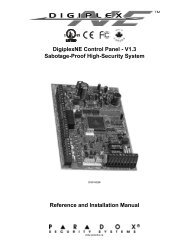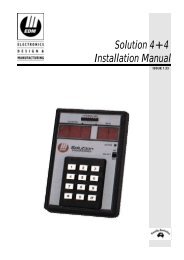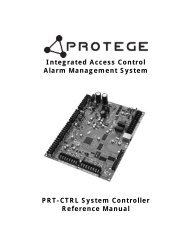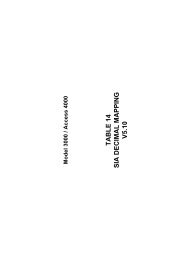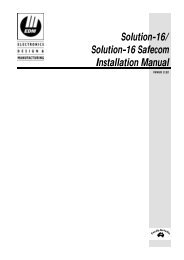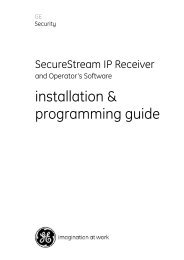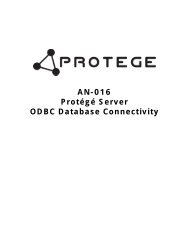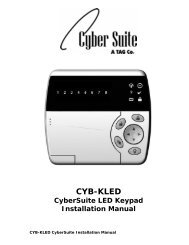PRX NPROX Proximity Multi Function Reader Quick Start Guide
PRX NPROX Proximity Multi Function Reader Quick Start Guide
PRX NPROX Proximity Multi Function Reader Quick Start Guide
Create successful ePaper yourself
Turn your PDF publications into a flip-book with our unique Google optimized e-Paper software.
WIEGAND CONNECTION<br />
When using the standard Wiegand Interface to the<br />
access controller or reader expander two wiring methods<br />
can be used. Dual LED operation allows the signalling of<br />
both LED's independently using the LED control lines and<br />
is ideal to show the status of alarm or other integrated<br />
signals.<br />
Figure 1 – Dual LED Connection<br />
Single LED allows a single LED line to control both LED<br />
AUX BUTTON INPUT<br />
Button input wiring configuration is shown in Figure 3. For<br />
programming options refer to the Protégé System Manual<br />
or the access controller manual for the system that the<br />
<strong>Proximity</strong> <strong>Reader</strong> is connected.<br />
Figure 3 - Button Input Wiring<br />
Connect a normally open button or switch as shown in<br />
Figure 3 and complete the programming within the Protégé<br />
Integrated System for the functionality required.<br />
External Button Input Mode and single LED<br />
operation must be enabled when using this<br />
wiring configuration. PROGRAMMING<br />
Entering Program Mode<br />
To program the Card <strong>Reader</strong> badge the programming<br />
card once, the Card <strong>Reader</strong> will beep to indicate the card<br />
has been read and then beep twice and illuminate the<br />
RED LED to indicate programming mode has been<br />
entered.<br />
Address Selection<br />
To select an address to program the programming card is<br />
presented to the card reader the number of times<br />
matching the address number.<br />
Address Programming Option<br />
1 Card Reading Format<br />
2 Data Output Format<br />
3 LED Configuration<br />
4 Intelligent Tamper Mode<br />
5 Auxiliary Button Input Mode<br />
6 Operating Mode<br />
7 Add Standalone Master Card<br />
8 RS485 Address<br />
9 Door Pre-Alarm Time<br />
10 Door Left Open Time<br />
11 Version Information<br />
12 Default<br />
15 Client Code Configuration<br />
For example to program address three (LED<br />
Configuration) the programming card will be presented to<br />
the card reader three times.<br />
The card reader will then respond by beeping twice and<br />
flashing the RED LED to indicate data entry mode has<br />
been entered and that the user should present the card<br />
the required number of times to set the desired option.<br />
colours.<br />
Figure 2 – Single LED Connection<br />
INSTALLER PROGRAMMING<br />
By default the ICT <strong>Proximity</strong> <strong>Reader</strong> is factory configured to<br />
send data in 26 Bit Wiegand Format, it will read all card<br />
formats and operate in the dual LED line mode. This<br />
configuration can be changed to suit system operating<br />
requirements.<br />
The programming card can only be presented<br />
within the first 2 minutes from when the card<br />
reader powers up.<br />
Entering an address value that does not<br />
exist will result in the reader timing out and<br />
a long Beep tone being generated.<br />
Data Programming<br />
To program a data value in the selected address location<br />
the same method as the address programming is used.<br />
Present the Programming Card to the reader the number<br />
of times matching the data value or option for the<br />
selected address. The card reader will then respond by<br />
beeping twice indicating the data was programmed<br />
correctly and return to the address selection mode. An<br />
invalid entry will result in a long tone being generated.<br />
The data can be entered again or allow the Nano Prox to<br />
timeout to select another address.



